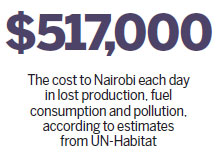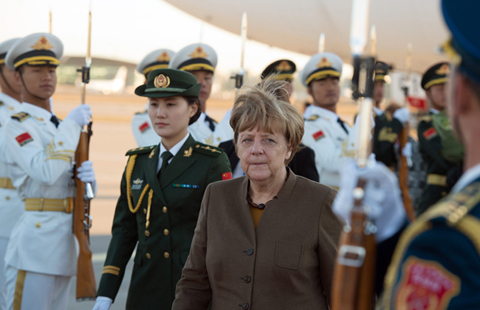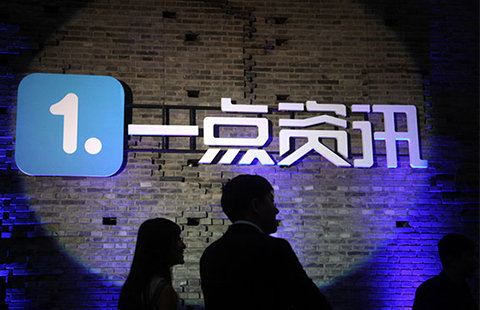
After years of virtually unchecked growth, efforts are being made to cure urban ills and set a new course, with help from China
In April, the governor of Nairobi County, Evans Kidero, took drastic steps to decongest the Kenyan capital's downtown by partially blocking roundabouts on major feeder roads. The roadblocks, which kept motorists from making right turns, have improved the flow of traffic, which had become nightmarishly clogged.
Residents told pollsters over the summer that they lost one hour or more in traffic every day. More than one-third of those surveyed said they lost a job or business opportunity because of transport problems, according to the first public opinion poll in Nairobi on transportation, funded by the Kenya Alliance of Resident Associations.
|
Traffic congestion in downtown Nairobi. Xinhua |
Traffic congestion costs the city $517,000 a day in lost production, fuel consumption and pollution, according to estimates from UN-Habitat, the United Nations Human Settlements Program.
On rainy days, burst sewer lines and clogged drainage often cause significant flooding, sometimes rendering major roads impassable, leading to massive traffic jams.
New systems are badly needed, says Felix Lukwa Lusiri, wastewater engineer of Nairobi City Water and Sewerage Co. However, he says, there is little hope of improvements for the old sewerage system in the city's central business district, an area too old and crowded to implement large-scale construction projects.
"The system is single channel, and storm rains and daily wastewater are running through the same trunk, which are supposed to be separated like in other new areas of the city," he says. "When rainy season comes it inevitably results in floods in the city that block the traffic."
Thus, he says, it is crucial to place new trunk lines across the city with durable materials like PVC pipes, to make the sewerage system run smoothly and sustainably, while educating citizens on proper waste disposal.
But while traffic and burst sewerage pipes are among the most visible of Nairobi's urban ills, they are not the only ones.
Jobson Ngari, an urban planner and consultant, attributes the city's woes to its history. The city rose rapidly from humble beginnings as a colonial outpost in 1899 to become a huge metropolis and financial, diplomatic and information hub.

It is on its way to becoming a highly competitive global urban economic hot spot, the Economist Intelligence Unit says. The east African city is touted to soon overtake Cairo as Africa's second-leading city after Johannesburg, according to a 2012 study, Hot Spots: Benchmarking Global City Competitiveness.
The study ranked cities according to their demonstrated ability to attract capital, business, talent and visitors.
But for this to be achieved, the city authorities must avoid getting bogged down under the persistent pressures of rapidly growing population, infrastructure deficits and uncontrolled development.
"A holistic approach is needed to ensure that all aspects of development are catered for," says Ngari, citing the challenges in transport, water and sanitation, environmental degradation and energy.
"You cannot address one without the other. The authorities need to balance growth and sustainability," he says.
There are signs of this beginning to happen, he notes. For one, a new master plan has been developed. For a long time, the city was using a pre-independence version from 1948 known as the Plan for a Colonial Capital. It was revised in 1973 but the Metropolitan Growth Strategy was never properly adopted or implemented, giving rise to uncontrolled urban development, insufficient infrastructure, an unplanned transport system and a dearth of mid- and low-income housing.
In June 2013, a new strategy called Nairobi Integrated Urban Development Master Plan was unveiled to guide growth and development of the city for the next 15 years. It was developed by urban planners from the Nairobi county government and the Japan International Cooperation Agency.
Still, its heavy reliance on foreign consultants has been unpalatable to some local professionals. "Some proposals are not applicable as they are costly," says Ngari, who has been a planner and researcher focusing on sustainable urban development for about 30 years.
"What we are working with right now is a strategic plan where planners need to identify priority areas and then buy the support of stakeholders through public consultative meetings."
This means that while the 2013 master plan is a guideline, managers - after identifying a project and securing its funding - undertake a comprehensive structured analysis as part of the strategic plan. That establishes the strengths, weaknesses, opportunities and threats involved. The goal is to prove that the project won't stall over financial issues and would be completed within five years.
"The project has to be relevant to the consumers living in the locality. The development must also be realistic and time bound," he says, adding that stakeholders' buy-in must also be secured to ensure a return on investment.
"So instead of having plans (only) on paper, realistic projects are developed and approved by the county government, which undertakes environmental impact assessment studies to promote sustainability."
Projects using this system have already started taking shape.
"The megamalls coming up at the periphery of the city bring services closer to the people," he says.
The city's rapidly expanding middle class is driving growth in the city suburbs. In areas known as satellite cities, there is a buzz of productivity as more people find work in these areas.
They include Westlands, Easeleigh, Langata and Gigiri, the latter of which includes a diplomatic zone that is home to Two Rivers, a planned 40-hectare mixed use, master planned community. The center is touted as the largest mall and "lifestyle" center in sub-Saharan Africa outside South Africa.
The project is a joint venture that includes China National Aero-technology International Engineering Corp, Jiangxi Water and Hydropower Construction, and Centum Investment Group of Kenya.
New neighborhoods are making use of mixed developments where social amenities and housing are included in the designs. "Residents in gated communities are able to access quality healthcare in hospitals within their environs. Schools and offices can also be found easily," Ngari says.
Recent examples are the Tatu city development and Konza Techno city, a government-backed project.
This method would also address the development of informal settlements that sprout at the edge of affluent neighborhoods, planners say. The modern developments have taken into consideration the needs of low-income workers who work there by ensuring that basic infrastructure such as piped-in water, proper sanitation and lighting are available, says Laila Macharia, chief executive of Africa Metro, an urban development investment company in Nairobi.
"Lighting and other basic amenities have already been factored in during the design stages. This will ensure that all development happening in the area is controlled."
The developments would ease pressures from downtown Nairobi as people will be able to work and live within a controlled environment, she says. Some plans also incorporate healthy lifestyles. "Cycling and walking will be encouraged, hence promoting a green environment," Macharia says.
In the Nairobi transport survey, a third of those polled, including those with access to a car, said they would consider riding a bike to get around, reflecting a growing interest among the middle class to go green.
Ngari also commends the move to construct bypasses. These are roads that redirect transport away from downtown areas and connect to other major roads leading away from the city's center. The government projects are financed by Beijing. There have also been efforts to expand major roads to key installations such as the airport.
"The projects have been completed within short timeframes, and modern technology has been used. We have seen some street lighting use solar power, which lessens energy costs for the Nairobi county government," he says.
A clear road maintenance strategy is needed, however, to ensure that the infrastructure is maintained, Ngari says. "Toll stations may soon be used so that motorists share the burden of ensuring that the roads are kept in good condition."
The launch of public-private partnership initiatives also would ensure that more modern infrastructure is implemented to ease the current deficit, he says.
"Modern techniques are grounded in sustainability. Most importantly, the projects will have undergone environmental impact assessment by the National Environment Management Authority, which has that capacity."
Contact writers at lucymorangi@chinadaily.com.cn and lilianxing@chinadaily.com.cn
(China Daily Africa Weekly 10/30/2015 page8)








